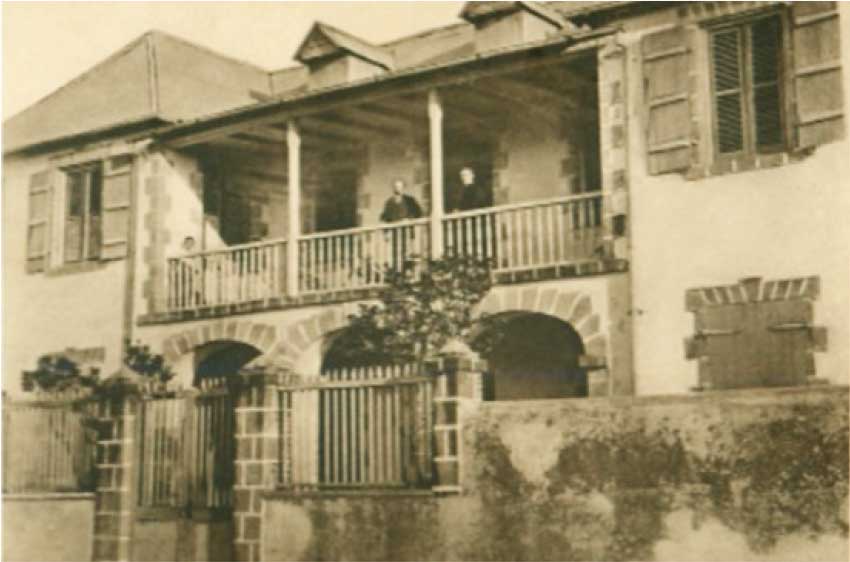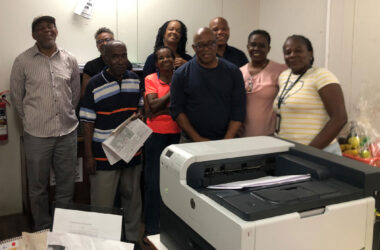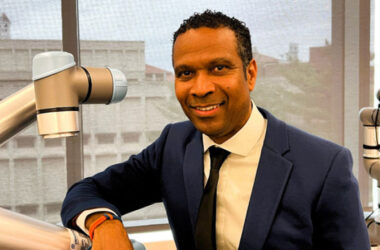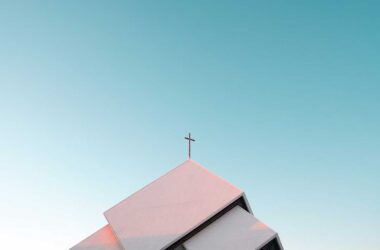At the 125th Anniversary Mass of St Mary’s College held at the Minor Basilica of the Immaculate Conception in Castries on the 17th May, 2015, Mr Calixte George astounded the audience largely comprised of current and past Samarians with his address in which he outlined an historical account of the administration of St Mary’s College from Inception in 1890 to the current period. Beginning with his detailed account on the exploits of the Founder of the school, Rev. Father Louis Tapon, in initiating this first secondary school in Saint Lucia and the strategy that he adopted in this effort, the discourse so aroused the interest of the audience that Calixte was exhorted by many in attendance to publish his story on this. This book is the fulfilment of this sentiment.

Chapter 1 has as heading “The Early Years.” The narrative begins with an historical outline on the state of education in the colony of Saint Lucia at the time when Rev. Fr. Tapon was laying down the foundation for establishing the school. The outline provides an expose of the local and comparative regional context in which the College was founded in 1890 and goes on to describe the journey of development of administration from founding to the arrival of the Presentation Brothers from Ireland in 1947. The account of the journey covers the challenges faced by Fr. Tapon in his fight to maintain sole management control of the College in the interest of ensuring the Catholic character of the school and to counter the concern of the Advisory Committee about a clergy of Frenchmen managing and controlling such a school in a British colony. Fr. Tapon’s efforts involved first his pursuit of an English education in England and later necessitated his appeal to the Archbishop of Port of Spain, Trinidad, who had exclusive control for such a Catholic owned institution in the Archdiocese.
The contentions in administrative control were ultimately resolved when Fr. Tapon agreed to fundamental strategies in administration including the establishment of a Visiting Committee. A fundamental objective was to have the school play an instrumental role in transforming the society from the dominance of French/Creole to English Language. The engagement of Head Masters who were graduates of English Universities was considered necessary for the overall objectives.
Calixte divides his discourse on the history of administration of the College into three epochs. This first chapter deals with the first epoch and outlines in great detail the names, country of origin, length of tenure and specialty inputs of these early Head Masters. There were sixteen of these early Head Masters between 1890 and 1946. From his extensive discourse of these, some interesting information come to light. The first of this concerns the problems encountered by the first English Headmaster, Mr F.E. Bundy (1890-1895) in getting the school off the ground and his unpopularity as he did not have a university degree. The succeeding Head Master, Mr Henry J Meagher (1895-1902) was born in Saint Lucia, of a prominent St Lucian family of Irish descent. He had a very successful impact on the performance of the school which was recognised in the sub-region. He left after seven years, presumably connected with unsatisfactory renumeration which had not yet benefited from Government assistance in response to Fr. Tapon/Advisory Committee agreements. Other Early Head Masters of historical interest included: Mr H.B. Cruse (1907-1912), notable for his achievements in sports establishment; Mr J.D. Fisher (1915-1919) who influenced establishment of the Island Scholarships; Acting Head Masters, H.G. Carrington (1919-1921) and J.E. Blackman (1923) who both originated from Barbados but not appointed Head Masters, evidently because they were not Englishmen; Mr. B.H. Easter (1923-1927 and lastly Mr Fox Hawes(1934-1946).
Calixte used writings of some locally prominent old boys of the times such as Sir Garnet Gordon, Hunter Francois, Victor Archer, Primrose Bledman and Charles Cadet to support his authentic historical accounts of the doings of some of these Head Masters.

Chapter 2 deals with the second epoch which the Author designated as “The Presentation Brothers’ Era” (1947-1975) and is centered on the changes introduced by the advent of Bro Canice Collins and the Presentation Brothers. The discussions of the happenings in this period effectively made this the epicentre of the story on St. Mary’s College as per Calixte George. He contends that this epoch was the first and key stage in the modernisation of the school with the introduction of science to the curriculum by Bro. Canice. He also placed special emphasis on the introduction of Agricultural Science in the curriculum by Bro Canice Collins and made reference to well known applied science and agricultural science professionals arising from that period of which Dr. J.E. Edmunds, Cyril Matthews, Francis Leonce and himself and some others named were prominent members of that group.
Calixte used the Speech night address of Bro Canice in 1949 to highlight the major impact that the latter was already having on the school at that early stage. One of the issues addressed was the plans to transfer the location of the school due to the growth in population of students. The address also made reference to the introduction of choral music and art, the engagement of Derek Walcott, already a promising poet, and the establishment of the Intending Teachers Scheme providing three year preliminary education and training for young primary school teachers. In this chapter, Calixte paid further homage to Mr Easter who was involved with Bro. Canice in creating the Archeological and Historical society during Mr. Easters’ second stint at St Mary’s College when he was further involved in introducing the then new and exciting subject of World Affairs.
Calixte made distinctive reference to the role of Bro Canice and fellow Presentation Brothers in their heroic efforts in saving the College from destruction by the great Castries fire of 1948. This effort has been generally credited for saving the remainder of Castries from destruction by that fire.
The Author gave an account of the transfer of the College to new premises at Vigie in 1952 and the vision of Bro. Canice for that new institution as re-produced from an article in the Voice of Saint Lucia (in January, 1952 ) entitled “St Mary’s on Way to Become Leading Windward Islands School.”
The chapter continues with accounts of the contributions of the other Presentation Brothers of the era of Bro. Canice Collins such as Bro. Lawrence Reynolds, Bro. Macartan Sheehy, Bro. Liam Dromey and Bro. Albert White and those who followed Bro. Canice as Head Masters such as Bro. Ignatius Flahive, Bro. Marcus O’Donovan, BroLiguoriO’Mahony. He also made reference to some indigenous Masters such as the iconic Harold Haynes and Hilton Andrew.
The Author ended his discourse of the major developments towards the end of this epoch with a brief account of the loss of the sixth form. He had earlier in the chapter made reference to the role of Prefects who generally came from the sixth form and who provided the operational management in the enforcement of School discipline. The Government of the day decided that all sixth forms should be consolidated in a sixth form college at the Morne. He deals with the consequential impact of this change in the following chapter.
Chapter 3 deals with The “Modern Epoch” (1976-2018) and represents the transition from control of the College by the Presentation Brothers of Ireland back to the local Roman Catholic Church and administered through a management Board with the Archbishop as Chairman. Reference was made earlier to the loss of the Sixth form to the College and this development forms part of the changes in the administration of the College which is dramatised in Calixte’s accounts of this epoch as a ‘Seismic’ shift which occurred in 1974 when the Government introduced a new educational bill which led to the College facing profound transformation.
This period began with Acting Head Mastership of Rev. Father Joachim Stack, earlier a Presentation Brother at the school, followed by Mr Harold Haynes who previously had a long association with the school in teaching and sports. In November 1980, Mr Michael Mondesir was appointed Head Master, the second Saint Lucian born to be in that position. He too had a long standing association with the school, first as a student and later as one of the longest serving Masters.
Calixte contends that arising from the unstable external environment which then existed, the virtues originally associated with the school were now under threat in the new transformational phase. He noted that His Grace Archbishop Kelvin Felix was fully aware of the environmental conditions that engulfed the Principal of the College, Mr Michael Mondesir and addressed that in a message of encouragement “Looking forward with Confidence”.
Not withstanding the challenges in managing the school in the new environment, Calixte credits Mr Mondesir’s tenure with a number of initiatives. These included appointing a Dean of Discipline, establishment of a Guidance Counselling Committee and formation of a Student’s Council. Additionally, and probably most significantly, Mr Mondesir had to navigate through the changes from Cambridge General Certificate Examinations through to the conversion to the Caribbean Examination Council (CXC). He also widened the subject offerings with a range of technical, social, business and arts subjects. These developments necessitated teaching staff expansion adding to the challenges of this era.
Rev. Fr. Linus Clovis later replaced Mr Mondesir as Principal and the former contributed to modernising the Physical Infrastructure and facilities for Information Technology and Language instructions.
Following retirements of Mondesir and Clovis, long standing tenure of the position was passed on to Mr. Rowan Seon who also experienced a long stint as a Master at the school. Calixte noted that Mr Seon continued to provide guidance and direction in maintaining a strong science orientation at the school which is now endowed with a number of well qualified, competent professional teachers, the result of which have been students attaining high academic standards with some exceptional performances in the CXC examinations. Calixte noted that the composition of the teaching staff has changed from about three females in the earlier days to 30 females in a total staff count of 45 in 2013.














I am in this school photo !!
I am English. I was at the school from 1949 to 1953 because my dad was on the UK team rebuilding Castries. I am just in front of Brother Canice and to his left. I am wearing white shirt and blazer
How amazing